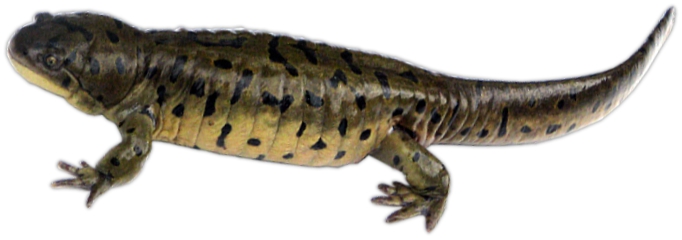Gray Tiger Salamander

What it looks like
The Gray Tiger Salamander is a large salamander. It can grow to be 33 cm long. They are usually an olive-green colour with dark patches or stripes on top and a lighter coloured belly. Some can be dark gray all over.
Look-alikes
A Gray Tiger Salamander looks a lot like an Eastern Tiger Salamander. The two are very closely related and used to be called the same kind. Gray Tiger Salamanders usually have lighter coloured bodies with dark spots or patches. Eastern Tiger Salamanders usually have dark coloured bodies with light coloured spots or patches.
Gray Tiger Salamander larvae can look like a Mudpuppy, but have rounder heads than a Mudpuppy and 5 toes on their hind feet. A Mudpuppy has only 4 toes.
Name
Tiger Salamanders get their name because some of them have dark stripes like a tiger. Most Gray Tiger Salamanders are gray in colour.
Scientific Name
The Gray Tiger Salamander's scientific name is Ambystoma mavortium. Learn what that means on this page: Scientific Names.
Where it lives
Gray Tiger Salamanders mainly live in grasslands near ponds or wetlands. They can be found in most of central North America. In Manitoba they live in the southwestern part of the province, west of the Red River Valley.
Where Gray Tiger Salamanders live in North America.
Habits
Tiger Salamanders (both kinds) are most active at night. These salamanders like to dig. They hide under rocks or logs in the day and hunt for food at night. They can dig their own holes in soft earth or they will crawl down holes other animals dig. For winter they dig deep into the ground or go down a hole left by another animal. They may be active down below the frost line all winter. They cannot freeze and survive like some frogs and treefrogs.
Food Web
These salamanders eat insects and other small invertebrates such as spiders, worms and snails. Gray Tiger Salamanders grow large enough that they might even eat small frogs. The larvae eat insects and other small water animals.
Tiger Salamanders (both kinds) taste bad to some birds and mammals. Snakes are probably their main enemies. Salamander larvae are eaten by wading birds like herons, and by turtles and snakes.
Life Cycle
Gray Tiger Salamanders mate and lay their eggs in deep ponds from late March into April. The female lays about 100 eggs. She lays them one at a time or in small groups on rocks, plants or sticks on the bottom of the pond. It takes 20 days for the eggs to hatch. The young can change to adult shape and leave the pond in late August or early September, about 60 days after hatching. They are about 10 to 15 cm long when they change to adult shape.
Sometimes the young salamanders take more than one summer to grow big enough to change to adult shape. They can stay in the pond over winter and keep growing through the next summer. It can take nearly 400 days to go from being an egg to changing to adult form.
Numbers
Gray Tiger Salamanders are very common in southwestern Manitoba. They are hard to find because they spend most of their time burrowing underground. No one knows how many there might be in one hectare.

A large Gray Tiger Salamander in hand!
Special Things
Tiger Salamanders (both kinds) are the largest salamanders in the world that live on land! Some Tiger Salamanders never grow up. They keep their gills and tail fin, and stay in the water all their lives.
How to Find Gray Tiger Salamanders
In spring look for adults in and around ponds right after the ice melts, from late March to mid-April. By the time Wood Frogs are starting to call Gray Tiger Salamanders will be breeding. Search the bottom of ponds with a flashlight after dark. They may not be visible during the day. Later on look in ponds for larvae. They look a bit like tadpoles, but are more slender and have feathery gills on the sides of their heads. In late August or early September watch for young adult salamanders leaving the ponds where they grew up. Sometimes many can be seen crossing roads near ponds.
Use by People
Some people use Gray Tiger Salamander larvae as bait to catch fish and some people keep adults as pets.
| Next: Eastern Tiger Salamander | Back to: Amphibians and Reptiles Front Page |
For more on Tiger Salamanders in NatureNorth.com follow these links:
Raising Tigers!| Salamander Cooperative | Tigers and Turbines!
